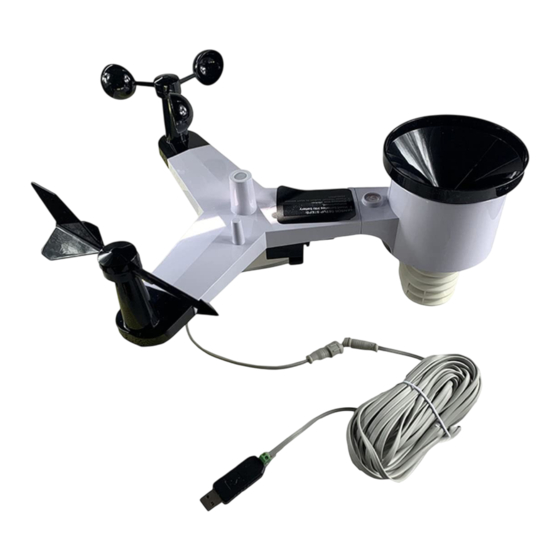
Advertisement
Advertisement
Table of Contents

Summary of Contents for Misol WH65LP
- Page 1 PROFESSIONAL WEATHER STATION Operation Manual...
- Page 2 1 Contents Item Y shape outdoor sensor(Thermo-hygrometer / Rain Gauge / Wind Speed Sensor /Transmitter) Wind Vane U-bolt with mounting clamps Zip bag for 1pc 10mm single-head wrench 2. Overview 1. Wind Vane 2. Wind Speed Sensor 3. UV sensor/ Light sensor 4.
-
Page 3: Setting Started
3. Setting Started 3.1. Install U-bolts and mounting pole Installation of the U-bolts, which are in turn used to mount the sensor package on a pole, requires installation of an included metal plate to receive the U-bolt ends. The metal plate, visible in Figure 1, has four holes through which the ends of the two U-Bolts will fit. -
Page 4: Install Wind Vane
Figure 2 The plate and U-Bolts are not yet needed at this stage but doing this now may help avoid damaging wind vane and wind speed cups later on. 3.2. Install wind vane Push the wind vane onto the shaft on the top of the sensor, unitl it goes further, as shown in figure 3. -
Page 5: Install Wind Speed
location. Permanent wind direction error will be introduced when the wind direction sensor is not positioned correctly during installation. 3.3. Install wind speed Push the wind speed into the shaft. as shown in figure 5. Tighten the set screw with as shown in figure 5. Make sure the wind speed spin freely. -
Page 6: Mount Assembled Outdoor Sensor Package
You can permanently damage the outdoor sensor Note: We recommend lithium batteries for cold weather climates, but alkaline batteries are sufficient for most climates. We do not recommend rechargeable batteries. They have lower voltages, do not operate well at wide temperature ranges, and do not last as long, resulting in poorer reception. -
Page 7: Reset Button And Transmitter Led
Finally, place the sensor package on top of the prepared mounting pipe. The U-Bolts should be loose enough to allow this but loosen the nuts as necessary. Once placed, hand tightens all four nuts, taking care to do so evenly. Now you will need to align the whole package in the proper direction by rotating it on top of the mounting pipe as needed. -
Page 8: Pre-Installation Checkout And Site Survey
Figure 11 3.7 Pre-Installation Checkout and Site Survey 3.7.1 Pre Installation Checkout Before installing your weather station in the permanent location, we recommend operating the weather station for one week in a temporary location with easy access. This will allow you to check out all of the functions, insure proper operation, and familiarize you with the weather station and calibration procedures. - Page 9 no interfering obstacles such as buildings, trees, vehicles, high voltage lines Wireless signals will not penetrate metal buildings. Under most conditions, the maximum wireless range is 100’. 5. Radio interference such as PCs, radios or TV sets can, in the worst case, entirely cut off radio communication.
-
Page 10: Maintenance
Metal 90-100% 4.Specification: Temperature range -40˚C--60˚C Accuracy + / - 1˚C Resolution 0.1˚C Measuring range rel. humidity 10%~99% Accuracy +/- 5% Rain volume display 0 – 6000mm (show --- if outside range) Accuracy + / - 10% Resolution 0.1mm (if rain volume < 1000mm) 1mm (if rain volume >... - Page 11 2. Clean the solar radiation sensor and solar panel every 3 months with damp cloth. 3. Replace batteries every 1-2 years. If left in too long, the batteries may leak due to environmental challenges. In harsh envir onments, inspect the batteries every 3 months (when cleaning the solar panel).

Need help?
Do you have a question about the WH65LP and is the answer not in the manual?
Questions and answers